
94% of researchers rate our articles as excellent or good
Learn more about the work of our research integrity team to safeguard the quality of each article we publish.
Find out more
ORIGINAL RESEARCH article
Front. Plant Sci. , 16 March 2022
Sec. Crop and Product Physiology
Volume 13 - 2022 | https://doi.org/10.3389/fpls.2022.862088
This article is part of the Research Topic Advances in Nitrogen Use Efficiency for Agriculture and Environment View all 36 articles
 Jinjin Wang1,2,3
Jinjin Wang1,2,3 Sadam Hussain1,2,3
Sadam Hussain1,2,3 Xu Sun1,2,3
Xu Sun1,2,3 Peng Zhang1,2,3
Peng Zhang1,2,3 Talha Javed4,5
Talha Javed4,5 Eldessoky S. Dessoky6
Eldessoky S. Dessoky6 Xiaolong Ren1,2,3*
Xiaolong Ren1,2,3* Xiaoli Chen1,2,3*
Xiaoli Chen1,2,3*
Developing a nitrogen fertilizer (N) reduction method under straw incorporation is essentially important for increasing wheat productivity in terms of improved fertilizer use efficiency and high yield in semiarid areas. A two-year field experiment, with five different nitrogen application rates: control (without N application, N0), low N (75 kg ha–1, N75), medium N (150 kg ha–1, N150), high N (225 kg ha–1, N225) and excessive N (300 kg ha–1, N300), was conducted in 2018 and 2019 to quantify their impacts on the photosynthetic characteristics, nitrogen utilization (in terms of N accumulation, distribution and transportation, and residual soil NO3–-N) and productivity of winter wheat. There was a significant impact of N rates on photosynthetic traits, and N accumulation in different organs. As compared with the N300, N150, and N225 improved the photosynthetic characteristics, increased N accumulation in grains by 5.55 and 10.97%, the N contribution proportion of that accumulated after anthesis by 67.90 and 115.56%, and reduced residual N by 62.50 and 46.48%, respectively, thereby effectively improved N absorption efficiency and N contribution rates. Grain yield remained slightly or unchanged among N treatments. Although N0 and N75 treatments reduced the nitrate-N leaching but caused a significant reduction of 18.13 and 28.37%, respectively, in grain yield. From these results, we conclude that N application at 150 and 225 kg⋅ha–1 under straw incorporation was the most effective fertilization method in achieving the higher photosynthetic characteristics, improving NUE and grain yield. This study provides theoretical and practical guidance for wheat production techniques.
Fertilizers, when applied at appropriate rate, have played an important role in increasing the crop productivity (Morari et al., 2011). Good fertilization practices, including as per recommended methods and rates, are very important not only for enhancing crop productivity but ensuring soil and environmental health (Yousaf et al., 2016a,b; Shah et al., 2017a). However, inadequate application of synthetic fertilizers, particularly nitrogenous fertilizers, have a negative impact on crop growth, the soil and the environment; it is predicted that increasing N fertilizers may cause an increase of 23–60% in N2O emissions by 2030 (FAO, 2009). China is among the largest consumer of chemical fertilizers in the world and overuse of synthetic fertilizers, including nitrogenous fertilizers, is a common practice to achieve the higher crops yield (Du et al., 2020). Increasing N inputs would decrease nitrogen use efficiency (NUE) and increase N losses and environmental pollution (Shah et al., 2017b; Bhattacharya, 2019; Zhang et al., 2019; Bhattarai et al., 2021). In a recent study, Gu et al. (2019) also demonstrated that long-term use of nitrogenous fertilizers has been resulted in enhancing the acidification, degradation, and soil compaction problems. Agricultural management practices, for example, the application of N fertilizers greatly influence soil health in term of soil organic carbon (SOC) content, crop growth, and developmental processes. Various reports have reported that reducing mineral N application along with the application of manures would be one of the best practices for enhancing crop performance through promoting soil health and NUE (Duan et al., 2016).
Guanzhong Plain, having an area of ∼ 34000 km2, is an important grain production base in Shaanxi Province and in China (Liu et al., 2014). Winter wheat is the main grain crop in this region. This region is rich in straw resources, but at the same time, the phenomenon of straw burning is very common (Zhu et al., 2016; Sun et al., 2017). Intensive planting mode without straw retention/incorporation reduced the soil organic matter and soil nutrients which reduced the reward effect of chemical fertilizer (Scotti et al., 2015). In order to pursue high crop yield and reduce cost, the phenomenon of excessive application of N and the “one blast” fertilization method are prevalent (Lou et al., 2011; Ju and Gu, 2014; Zhao et al., 2016; Hafeez et al., 2019; Shah et al., 2021a,b; Yousaf et al., 2021), causing serious loss of N and reduced NUE, which not only wastes resources but also causes serious environmental pollution (Jin et al., 2012; Wei et al., 2015; Zhao and Yin, 2015). Agricultural production in this region lacks scientific and reasonable fertilization guidance.
Straw incorporation can increase soil organic matter, reduce fertilizer input, and increase the reward effect of chemical fertilizers (Zhang et al., 2016). It is commonly considered that fertilizers play a significant role in the continuous increase in the productivity of agricultural crops (Lou et al., 2011). Currently, considering the environmental benefits and better crop yield that sustainable agriculture management provides, a combination of N fertilizer application with straw incorporation is recommended as a sustainable and environment-friendly approach by researchers (Bakht et al., 2009; Liao et al., 2015; Xu et al., 2019; Zhang et al., 2019) and government agencies (MEP, 1999; MOA-PRC, 2015) to increase the soil EC, improve soil fertility status and minimize the environmental problems. Crop straw incorporation or retention is commonly believed to have a positive influence on the soil quality, soil carbon and N dynamics (Ghimire and Machado, 2015). It will promote soil productivity, soil organic C sequestration and NUE (Liu et al., 2014). Various studies have demonstrated that straw incorporation can enhance the carbon inputs which can result in enhancing the organic matter contents and accumulation of essential nutrients that ultimately enhance nutrient use efficiency of crop plants (Li et al., 2010; Tong et al., 2014; Yuan et al., 2021). It is also well documented that straw incorporation positively affected the activities of various beneficial microbes to facilitate in protecting the soil environment for sustainable agricultural production (Garg and Bahl, 2008). However, results of previously published reports on the efficacy of straw incorporation treatments for crop yield and environment were inconsistent, showing either positive (Huang et al., 2017), negative (Yao et al., 2017; Xu et al., 2021), or neutral effects (Zhang et al., 2017). Fertilization had a significant effect on soil health and productivity, and soil GHGs emissions (Liu et al., 2017). N application, when exceeds crop demand, has been reported to increase the primary production of GHGs, particularly N2O, in most terrestrial ecosystems, mainly due to its primary effect on soil N pool (Elser et al., 2007; Xu et al., 2019) and decreasing the NUE (Zhang et al., 2019). Therefore, it is imperative to find the best application rate to reduce the N losses and associated environmental problems.
At present, only limited studies have investigated the effects of reducing N on the basis of straw incorporation for winter wheat production in semiarid areas (Weller et al., 2015; Liang et al., 2017). And the conclusion is still inconclusive (Yin et al., 2018). Furthermore, there is still a lack of knowledge whether better photosynthetic processes, crop productivity and high NUE can be reconciled by optimizing fertilization regimes under straw incorporation. Thus, in this study, in order to find the best fertilization management, we set decreasing N fertilization treatments under the condition of traditional N to find the best choice for increasing the productivity of the wheat crops. Specific objectives of this study were to: (1) investigate the effect of N fertilizer on wheat growth, photosynthetic characteristics, N utilization (N accumulation, distribution and transportation, and residual soil –3–-N) and grain yield; (2) and provide a new direction for optimizing wheat N fertilizer management in semi-arid areas of China. For this study, we hypothesized that the conventional rate of N replaced by reduced N dose would promote the photosynthetic process, crop productivity, increase NUE in terms of high N accumulation in different plant organs and reduce leaching losses under straw incorporation conditions. Results of this experiment would help to identify the most efficient N application rate for achieving better crop growth, sustainable wheat grain yield, and high NUE under straw incorporation in semiarid areas.
Field experiments were conducted over two consecutive years (2018–2019) at the Institute of Water-saving Agriculture in Arid Areas of China (IWSA), at Northwest A&F University, Yangling (E108°04′, N35°20′) Shaanxi Province, China (Figure 1). This area is typically a semi-arid area which is located at the northern foot of the Qinling Mountains and on the Toudaoyuan in the west of the Weihe Plain. The experimental site is characterized as a hilly, dry flat land in the abdomen of the Loess Plateau with Lou soil type. Table 1 shows the nutrient content of wheat straw for returning to the field during the next wheat season and the soil nutrient content of the 0–60 cm soil layer before planting. Soil physical and chemical properties of above 0–20 cm were as follows: (i) soil bulk density 1.25 ± 0.3 g⋅cm–3, SOM 11.97 ± 0.95 g⋅kg–1, available N 53.12 ± 2.45 mg⋅kg–1, available P 22.34 ± 1.24 mg⋅kg–1, available K 97.37 ± 4.56 mg⋅kg–1 and pH 7.59 ± 0.58.
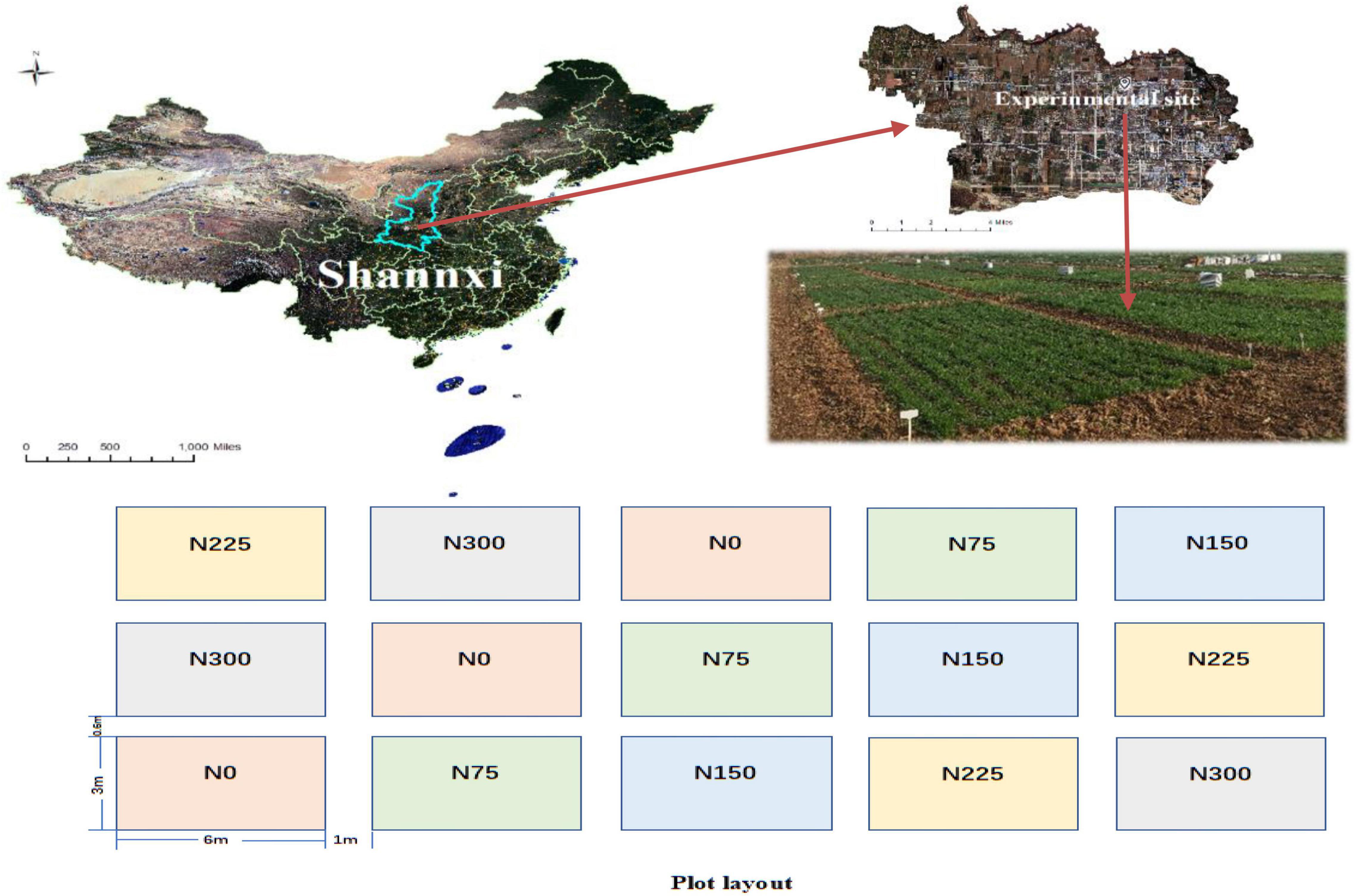
Figure 1. Location of the experimental site and layout of the field plots randomly distributed with N application rates. N0, unfertilized control; N75, 75 kg N⋅ha– 1; N150, 150 kg N⋅ha– 1; N225, 225 kg N⋅ha– 1; N300, a traditional N application rate 300 kg N⋅ha– 1.
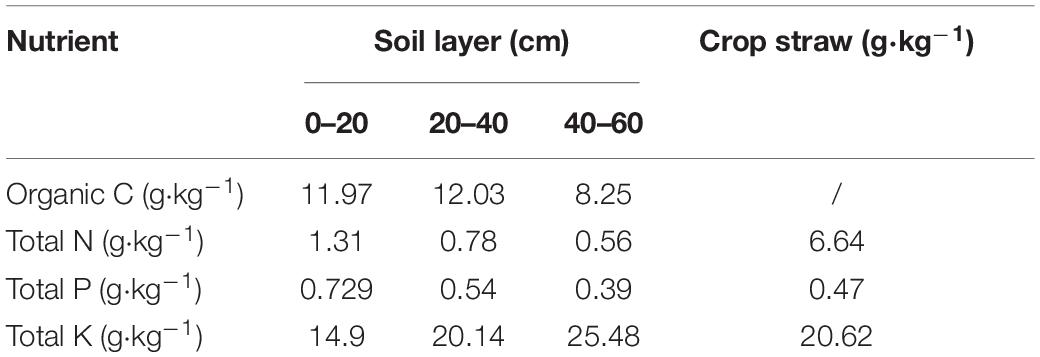
Table 1. Nutrient contents of incorporated wheat straw and soil nutrient contents in different soil layers before planting (g⋅kg–1).
In the past 40 years, the average annual temperature is 13.5°C, annual average rainfall was 540–625 mm, where most of rainfall occurred during July and September, and annual evaporation was 993.2 mm. The average temperature and rainfall during the growth period of wheat are shown in Figure 2. The average temperature during the whole growth period of winter wheat (from October to June) in the first year (2017–2018) and second year (2018–2019) of the experiment was 9.0 and 8.9°C, respectively. The rainfall during the whole growth period in the first year (2017–2018) and second year (2018–2019) of the experiment was 179.0 and 186.0 mm, respectively.
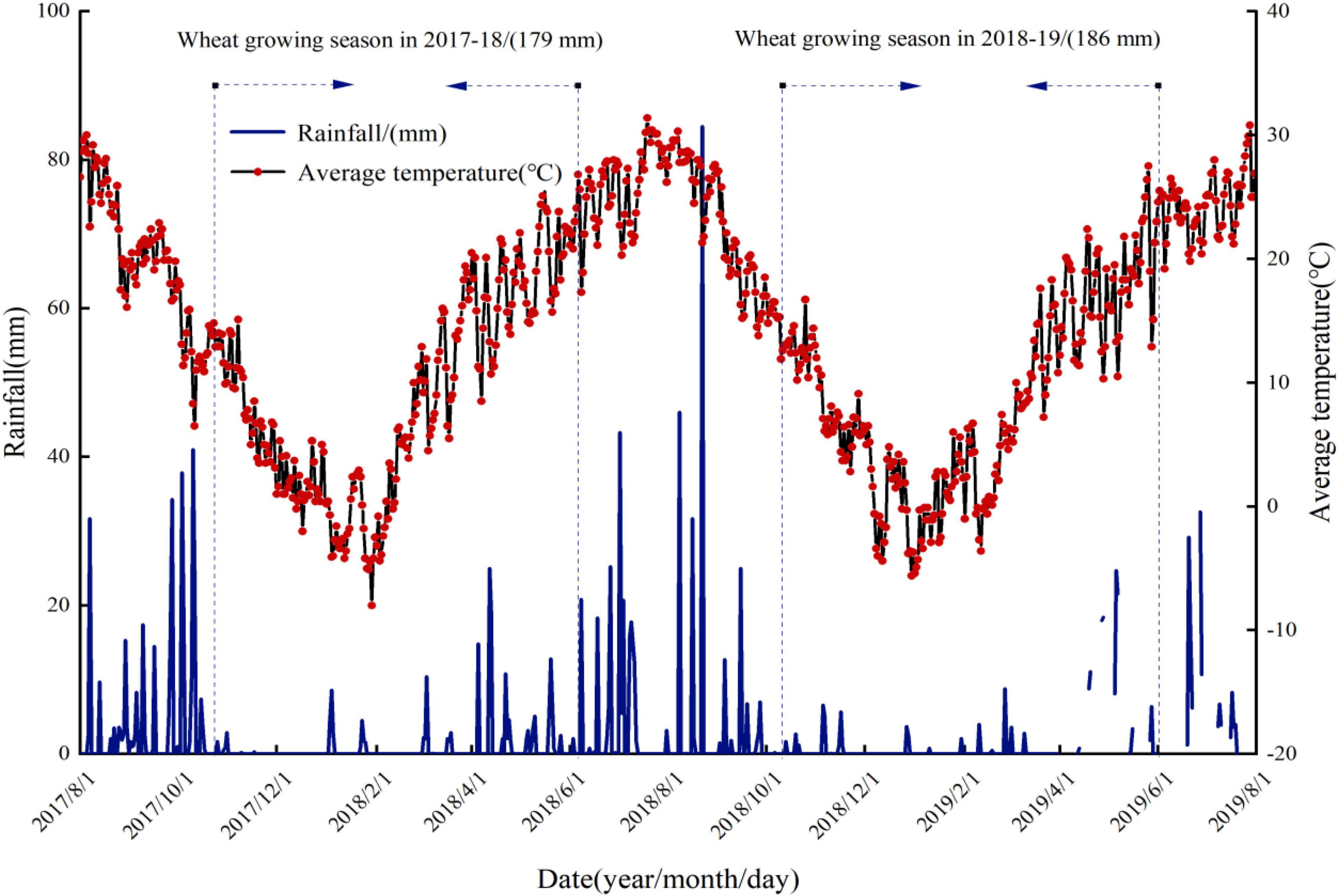
Figure 2. Rainfall and average temperature during the winter wheat growing seasons in 2018 and 2019 in Yangling, China.
The area planting system is winter wheat - leisure. The seedbed preparation included mechanical crushing of the whole wheat straw and return to the soil, this was followed by 15 cm deep plowing. The wheat straw (4500 kg⋅ha–1) was returned to the field before sowing. The nutrient contents of used straw were: (i) 6.64 ± 0.56 g kg–1 total N, (ii) 0.47 ± 0.01 g kg–1 total phosphorus (P), (iii) 20.62 ± 1.21 g kg–1 total potassium (K). The site was planted with winter wheat, where its cultivar Xinong-979 was sown, keeping an inter-row spacing of 20 cm. The seeds of winter wheat were sown in the mid-October and harvested in the first week of June during both study years. The plot area was 18 m2 (6 m × 3 m), with 3 replicates and a completely random arrangement. No irrigation was applied during the growing period of crop and other management practices were the same as local practices. The recommended dose of phosphorus and potassium was applied at 150 kg⋅ha–1 P2O5 and 60 kg⋅ha–1 K2O, using calcium phosphate and potassium chloride. N fertilizer using urea, five N treatments (0, 75, 150, 225, and 300 kg⋅ha–1, abbreviated as N0, N75, N150, N225, N300), was applied as the basal application to be consistent with the local farmer community.
In the crucial growth period of winter wheat, at the flowering stage, values were recorded during a sunny day between 9:00 – 11:00 a.m. The net photosynthetic rate (Pn), stomatal conductance (Gs), transpiration rate (Tr) and intercellular CO2 concentration (Ci) of flag leaves were measured by li-6400 photosynthetic apparatus manufactured in the United States, and the SPAD values using flag leaves were measured by SPAD apparatus, which was repeated for 10 times. The leaf area per plant was measured at the jointing stage, flowering stage, middle and late filling stage. Ten plants having similar growth trends were selected for each experimental plot, and the length and width of leaves were measured from all green fully expanded leaves. Then, the length and width coefficient method was applied to calculate the leaf area of each leaf by using the following equation: leaf area = length × width × 0.75. Leaf area index (LAI) was calculated as follows:
At the flowering and maturity stage, samples were taken from the center of the experimental plot dedicated to sampling, and ten (10) plants were sampled from each plot, and further separated into different parts as: leaf, stem + leaf sheath, glume + cob, grain and other organs. For analyzing the N concentration through the Kjeldahl method, firstly, the samples were oven-dried at 110 °C for 30 min, and later at 80°C to get a constant weight. Nitrogen accumulation and translocation in plant organs were calculated according to the method of Stevens et al. (2005) as follows:
Where, NAVOF and NAVOM are the accumulation of nitrogen in vegetative plant organs at flowering and maturity stage, respectively (kg⋅ha–1).
Soil samples were collected from three random soles from a 2 m soil layer from the center of each plot after harvesting winter wheat in early June of 2018 and 2019. Three sets of soil samples from each experimental unit were randomly taken from three locations within the 0–200 cm soil profile by using a core sampler (15 cm high and 5 cm diameter). Well sieved soil samples (2 mm), from deep 2 m soil layer, were refrigerated to measure the soil NO3–-N concentration for consideration of NH3–-N leaching. A mixture containing 5.0 g of fresh sieved soil (<2 mm) extracted with 50 ml of 1 mol⋅L–1 KCL solution was used for determining the soil total NH4+-N and NO3–-N. After filtration with Whatman filter paper (No. 42), AA3 continuous flow analyzer was used to analyze the extract solution, according to the method of Norman and Stucki (1981). The soil bulk density was determined by the ring knife method, for that, five replicates were taken from the top-soil layer and three replicates were from below the soil layer. The samples were put in an oven at 105 ± 2 °C for 4 h, and then cooled the samples in a desiccator and weigh to a constant weight.
The nitrogen harvest index (NHI), agronomic efficiency nitrogen (AEN), partial factor productivity (PFP) and recovery efficiency nitrogen (REN) were used for the determination of nitrogen use efficiency (NUE), according to the procedure of (Dobermann, 2005; Jin et al., 2012; Hartmann et al., 2015) as follows:
Where GN is nitrogen content in grains; TPN denotes the total uptake of N by the wheat plant; TP0 denotes the total uptake of nitrogen by the wheat plant under control condition; F denotes the amount of applied N; Y is the grain yield with applied N; Y0 is the crop yield under N0 treatment.
NO3–-N content was calculated as follows:
Where c denotes the quantity of soil NO3– -N (mg⋅kg–1); C0 is the mass concentration of test solution obtained from the curve (μg⋅mL–1); 50 is the total volume of the colorimetric test solution used (mL); vT denotes the total extract volume used (mL); v is the volume of the filtrate drawn; w is the mass of the dry soil sample (g).
The accumulation of NO3–-N in the soil is the sum of the individual accumulated amount of NO3–-N in each soil layer at a depth of 0–2 m, the formula is as follows:
Where A and c are the accumulation of NO3–-N (kg⋅ha–1) and soil layer NO3–-N concentration (mg⋅kg–1), respectively; BD and h are the soil bulk density (g⋅cm–3) and thickness of soil layer (cm), respectively.
Residual nitrogen was calculated as follows:
Where An and A are the accumulation of NO3–-N in fertilized area after planting the crop (kg⋅ha–1) and the accumulation of NO3–-N in the non-fertilized area (kg⋅ha–1), respectively.
Where c is the total N application (kg⋅ha–1).
At maturity, three central rows were harvested from each plot. The harvested plants were threshed using a mini thresher to separate the grains. The grains were weighed to record the grain yield.
Primary data from the experimental unit were computed using Microsoft Excel 2010. Differences among the nitrogen treatments were separated by analysis of variance technique, and mean values were compared to calculate the least significant difference (LSD) at the 0.05 level using SPSS-19.0 software. Origin 2021 software was used for regression analysis and graphing.
Nitrogen treatments significantly affected the photosynthetic traits during both study years. As sown in Figures 3, 4, maximum LAI at different growth stages and SPAD values were recorded for N300 which were statistically the same as N225 during both study years. However, minimum values of these traits were recorded for N0 followed by N75, N150, and N225 (Figures 3, 4). Similarly, higher net photosynthetic rate (Pn), stomatal conductance (Gs), and transpiration rates were recorded for N225 during both study years as compared with N0. When compared with control, N225 increased Pn by 113.12 and 25.43%, Gs by 188.89 and 25% and transpiration rate by 155.92 and 17.39% in 2018 and 2019, respectively (Table 2). In contrast, N225 treatment recorded a maximum reduction in intercellular CO2 concentration by 27.08 and 9.03% in 2018 and 2019, respectively, compared to the control treatment.
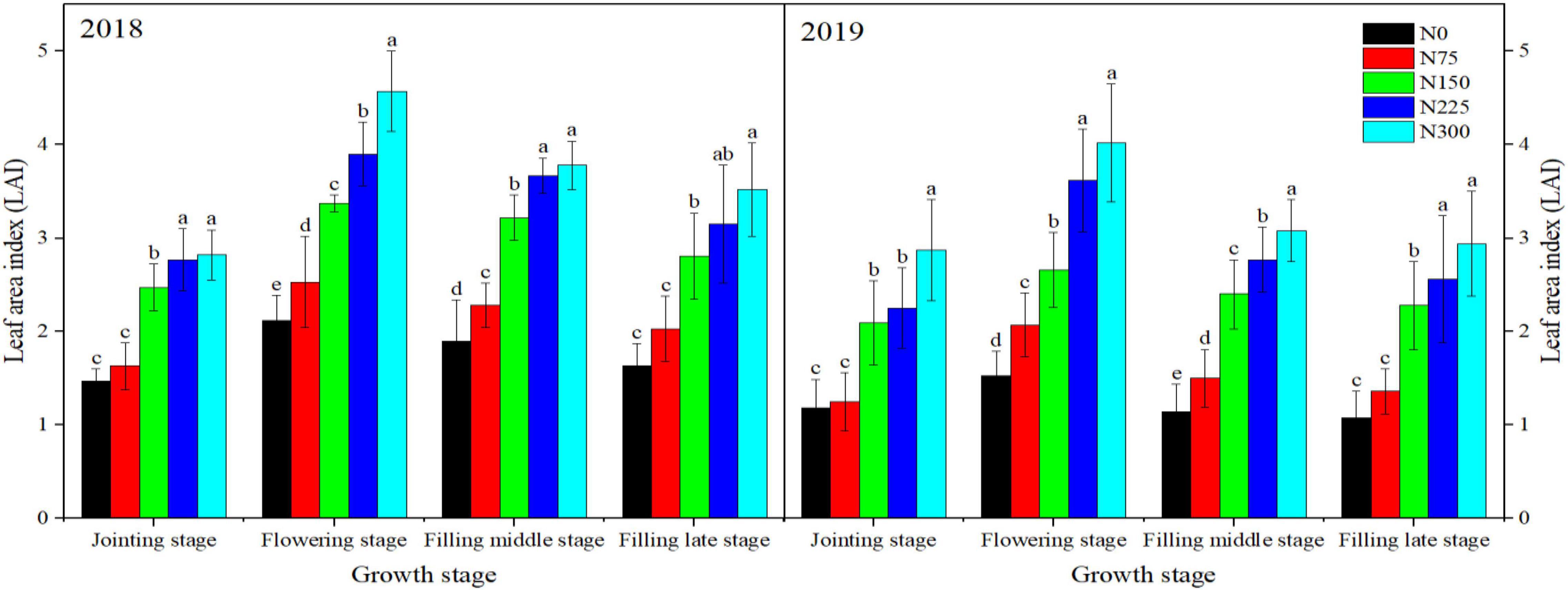
Figure 3. Impact of different nitrogen (N) application rates on leaf area index at different growth stages in winter wheat during 2018 and 2019. Above bars, different small letters show significant differences among N treatments at each growth stage. N0: unfertilized control; N75: N application at 75 kg N⋅ha– 1; N150: N application at 150 kg N⋅ha– 1; N225: N application at 225 kg N⋅ha– 1; N300: traditional N application rate of 300 kg N⋅ha– 1.
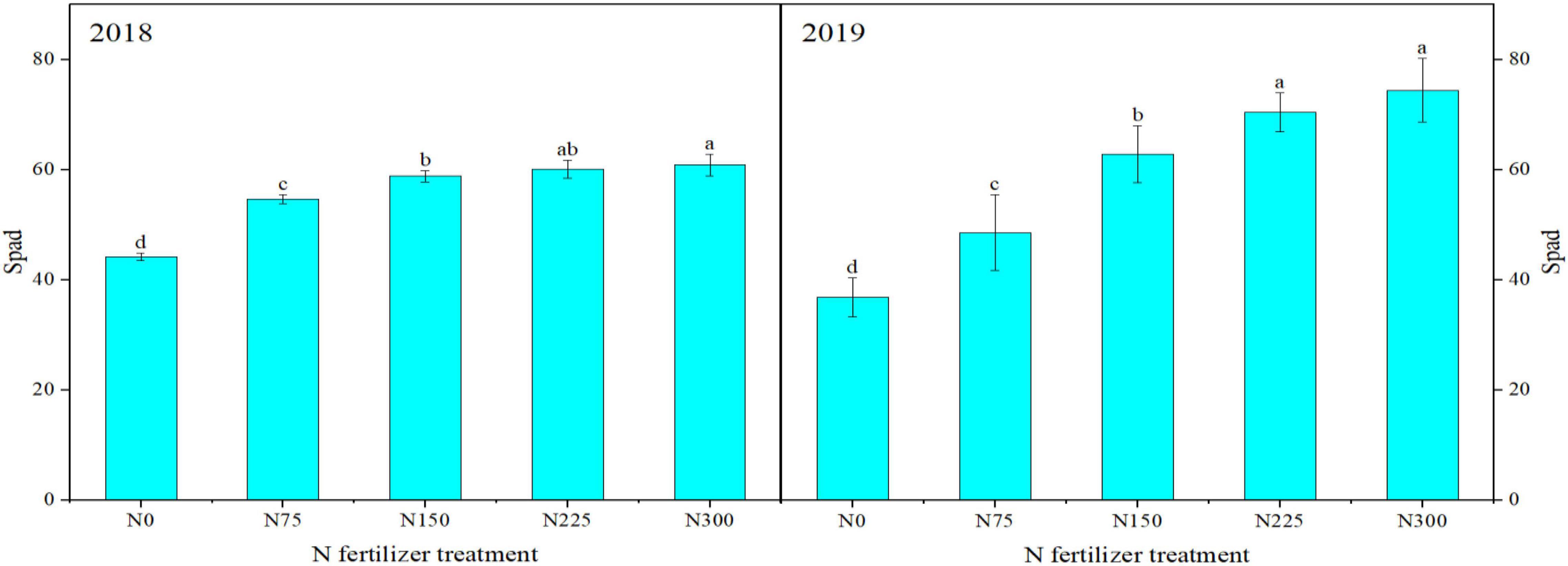
Figure 4. Influence of different nitrogen (N) application rates on SPAD values at flowering stage in winter wheat during 2018 and 2019. Above bars, different small letters show significant differences among N treatments. N0: unfertilized control; N75: N application at 75 kg N⋅ha– 1; N150: N application at 150 kg N⋅ha– 1; N225: N application at 225 kg N⋅ha– 1; N300: traditional N application rate of 300 kg N⋅ha– 1.
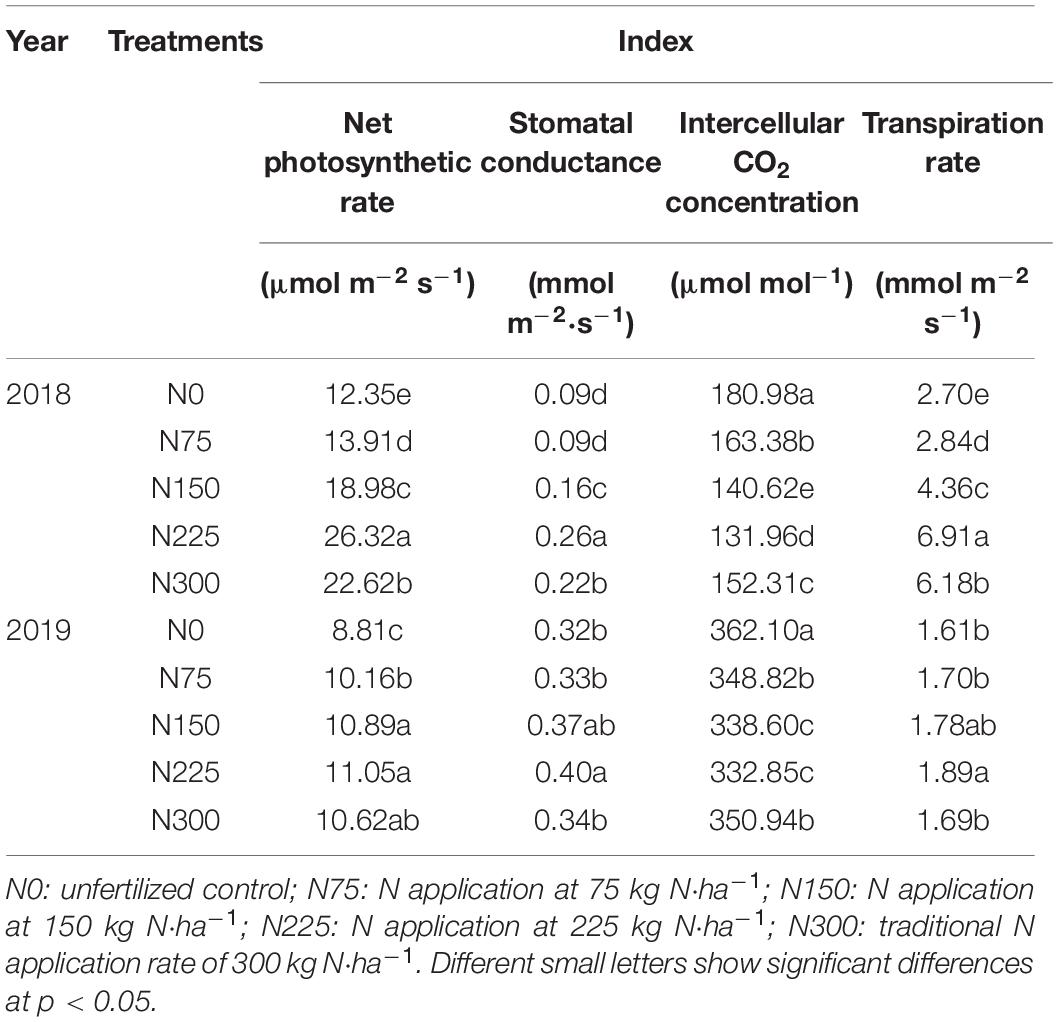
Table 2. Effects of different N application rates on net photosynthetic rate, stomatal conductance, intercellular CO2 concentration and transpiration rate at flowering stage of winter wheat in 2018 and 2019.
Nitrogen distribution in different plant organs was significantly affected by N treatments during both experimental years at the flowering and maturity stage (Tables 3, 4). At the flowering stage, maximum N accumulation in spike axis + husk and leaf were recorded for N300 which was statistically the same as N225, however, maximum N accumulation in stem + sheath was recorded for N225 during both years. For total N accumulation, maximum values were recorded for N330 during both years, which was statistically similar to N225 in 2018. At maturity stage, maximum N accumulation in grains, spike axis + husk, and leaf + spike + sheath was recorded for N300 followed by N225 during both experimental years (Table 4). Similarly, for total N accumulation, maximum values were recorded for N300 which were statistically similar to N225. For total distribution proportion, maximum values (18.40 and 16.88%, in 2018 and 2019, respectively) were recorded for N300 flowered by other N treatments.
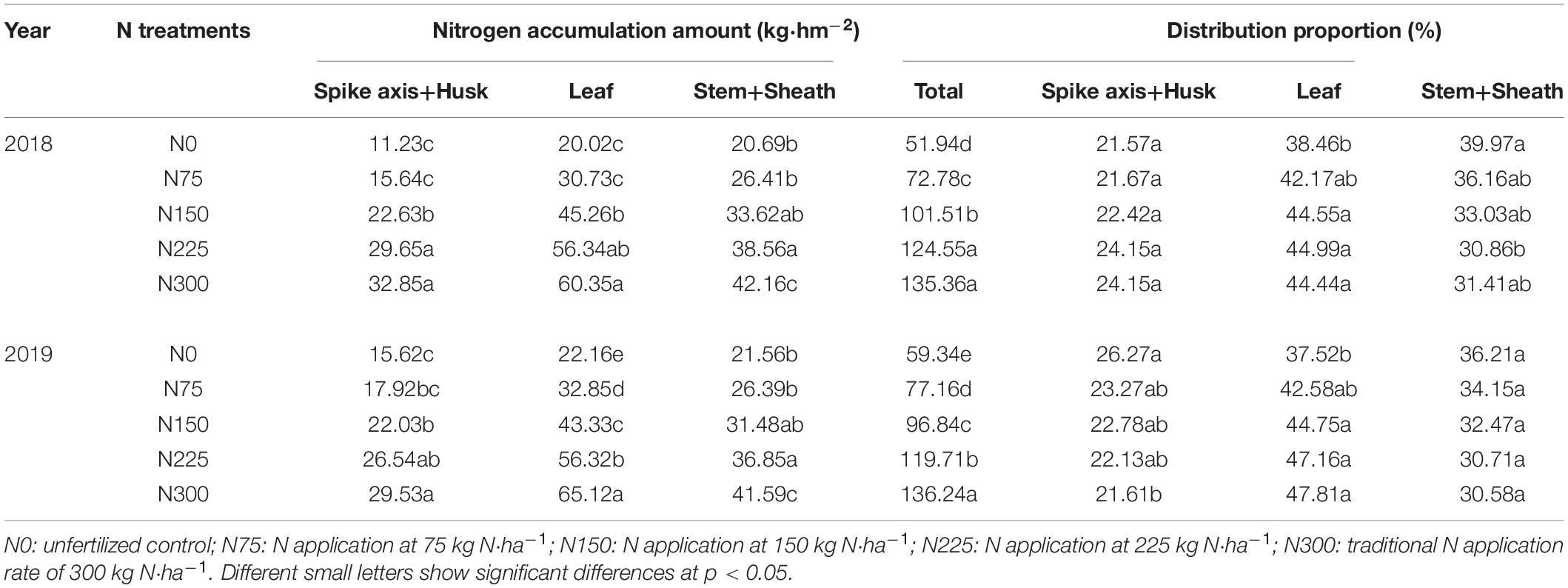
Table 3. Nitrogen accumulation and distribution proportion in different organs at flowering stage of winter wheat in 2018 and 2019 under different nitrogen application rates.
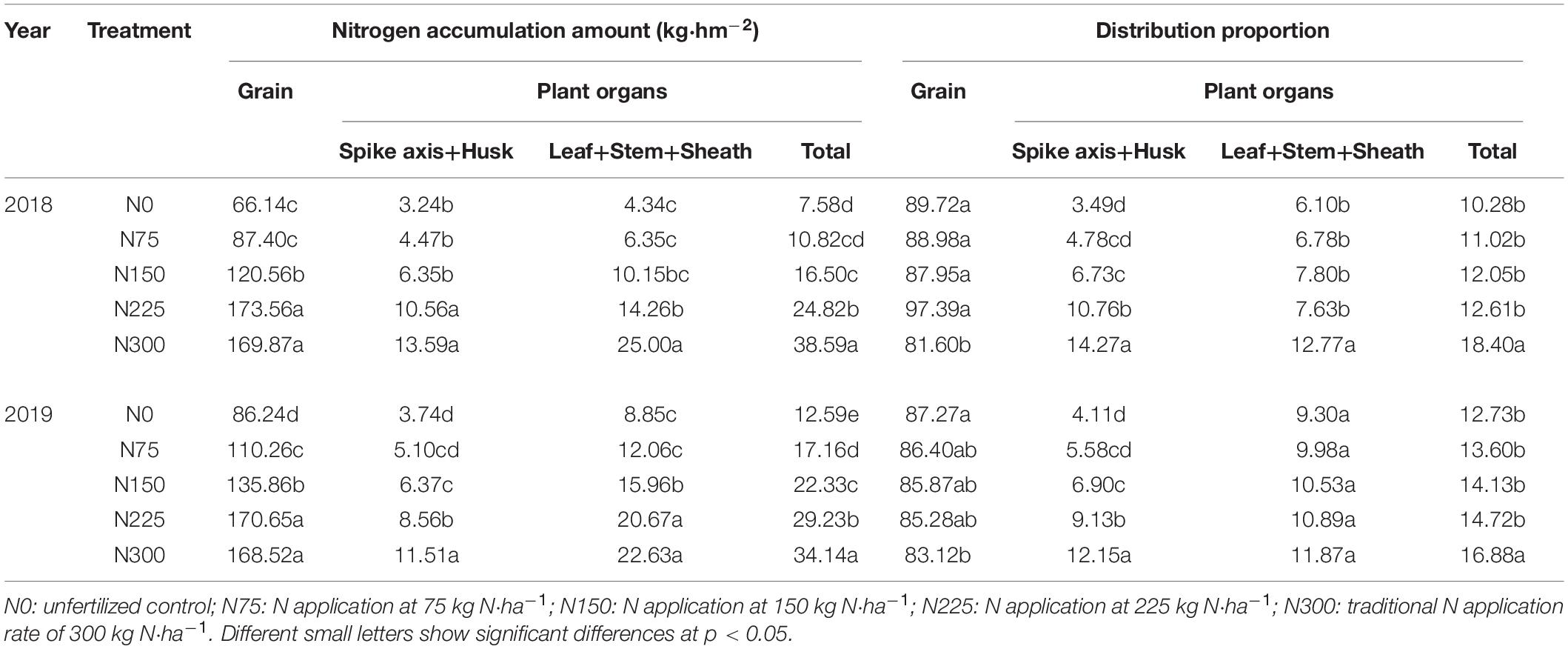
Table 4. Nitrogen accumulation and distribution proportion in different organs at maturity stage of winter wheat in 2018 and 2019 under different nitrogen application rates.
Nitrogen accumulation amount in kernels after flowering stage, N translocation amount from vegetative organs to kernel, N contribution proportion of that accumulated after anthesis stage and N contribution proportion from vegetative organs varied significantly for N treatments where maximum N accumulation amount in kernels after flowering stage and N translocation amount from vegetative organs to kernels was recorded for N300 followed by N225 whereas minimum was recorded for control treatment without N application during both study years (Figure 5). For N contribution proportion of that accumulated after anthesis stage, maximum values were recorded for N75, N150, and N225 followed by control treatment without N application, however, minimum was recorded for N300. Similarly, for N contribution proportion from vegetative organs, N300 and N0 significantly increased the values followed by other treatments (Figure 5).
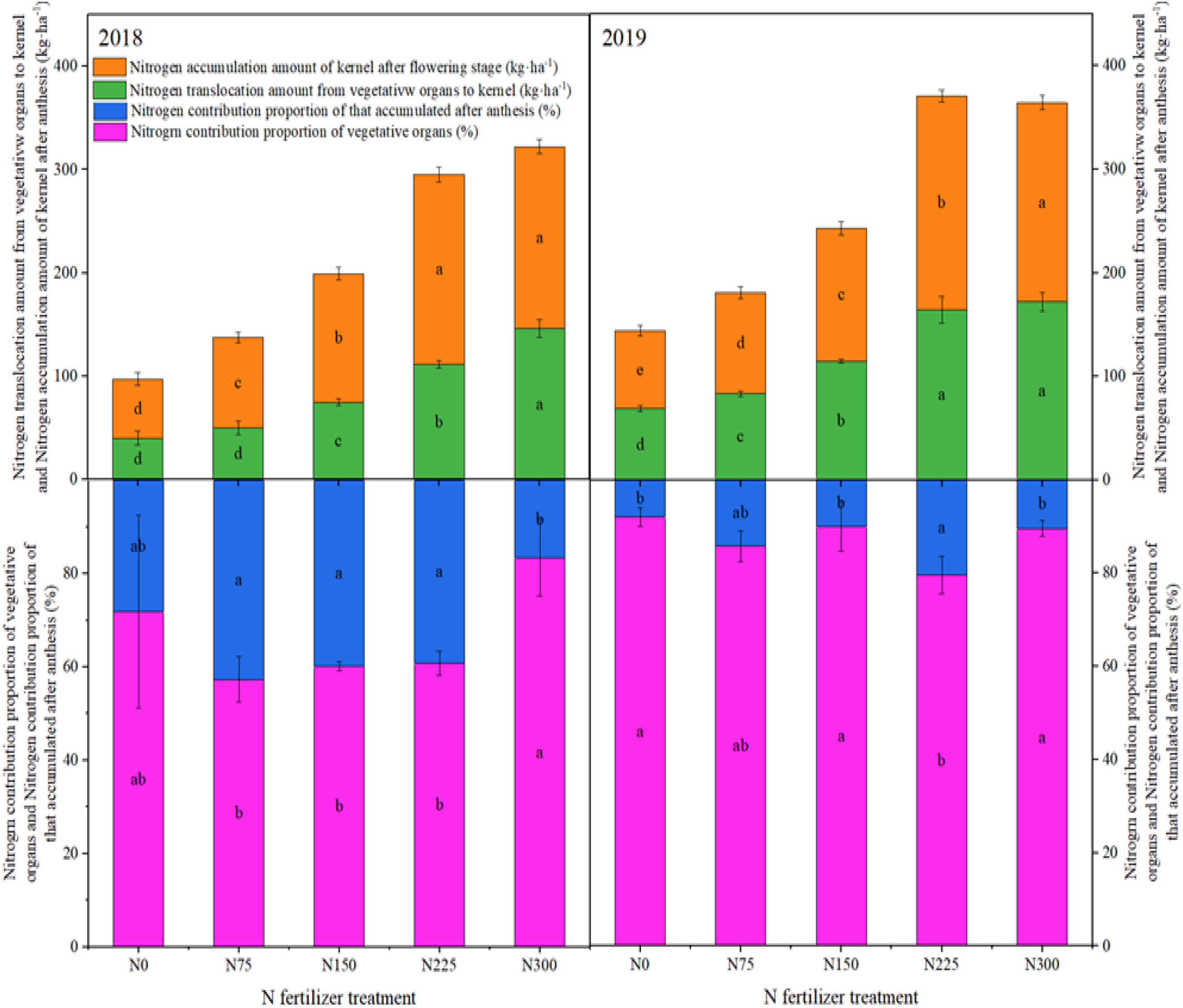
Figure 5. Influence of different nitrogen (N) application rates on N accumulation amount of kernel after flowering stage, N translocation amount from vegetative organs to the kernel, N contribution proportion of that accumulated after anthesis stage and N contribution proportion from vegetative organs in winter wheat during 2018 and 2019. In bars of specific colors, different small letters show significant differences among N treatments. N0: unfertilized control; N75: N application at 75 kg N⋅ha– 1; N150: N application at 150 kg N⋅ha– 1; N225: N application at 225 kg N⋅ha– 1; N300: traditional N application rate of 300 kg N⋅ha– 1.
As shown in Table 4, NHI was decreased with increasing N rates during both study years. However, for N fertilizer recovery efficiency, values were increased with increasing N rate in 2018, and the values were statistically the same for all N treatments in 2019. For N fertilizer contribution rate, the maximum percentage of 22.69 and 40.02% in 2018 and 2019 were recorded for N225 as compared with N0 where minimum values were recorded (Table 5). However, there was an opposite trend for N-fertilizer partial factor productivity and agronomic efficiency of N fertilizer where maximum values were recorded for control treatment without N application.

Table 5. Effect of nitrogen (N) application rates on grain yield, N fertilizer recovery, N fertilizer contribution efficiency, N fertilizer partial factor productivity and agronomic efficiency of N fertilizer in winter wheat during 2018 and 2019.
The NH3–-N, NH4+-N, residual N and N apparent residual rates in 2018 and 2019 are shown in Figure 1. The NH3–-N contents increased with the increase in soil depth and N application rates (Figure 6). The straw effect gradually appeared over time, which reduced the NH3–-N leaching during the second year. The positive influence of N treatments on NH4+-N was as N150 > N225 > N75 > N0 > N300. Residual N amount and rates were increased gradually with the increase of N application rate in 2018 and 2019, indicating that appropriate N can reduce N losses (Figure 6).
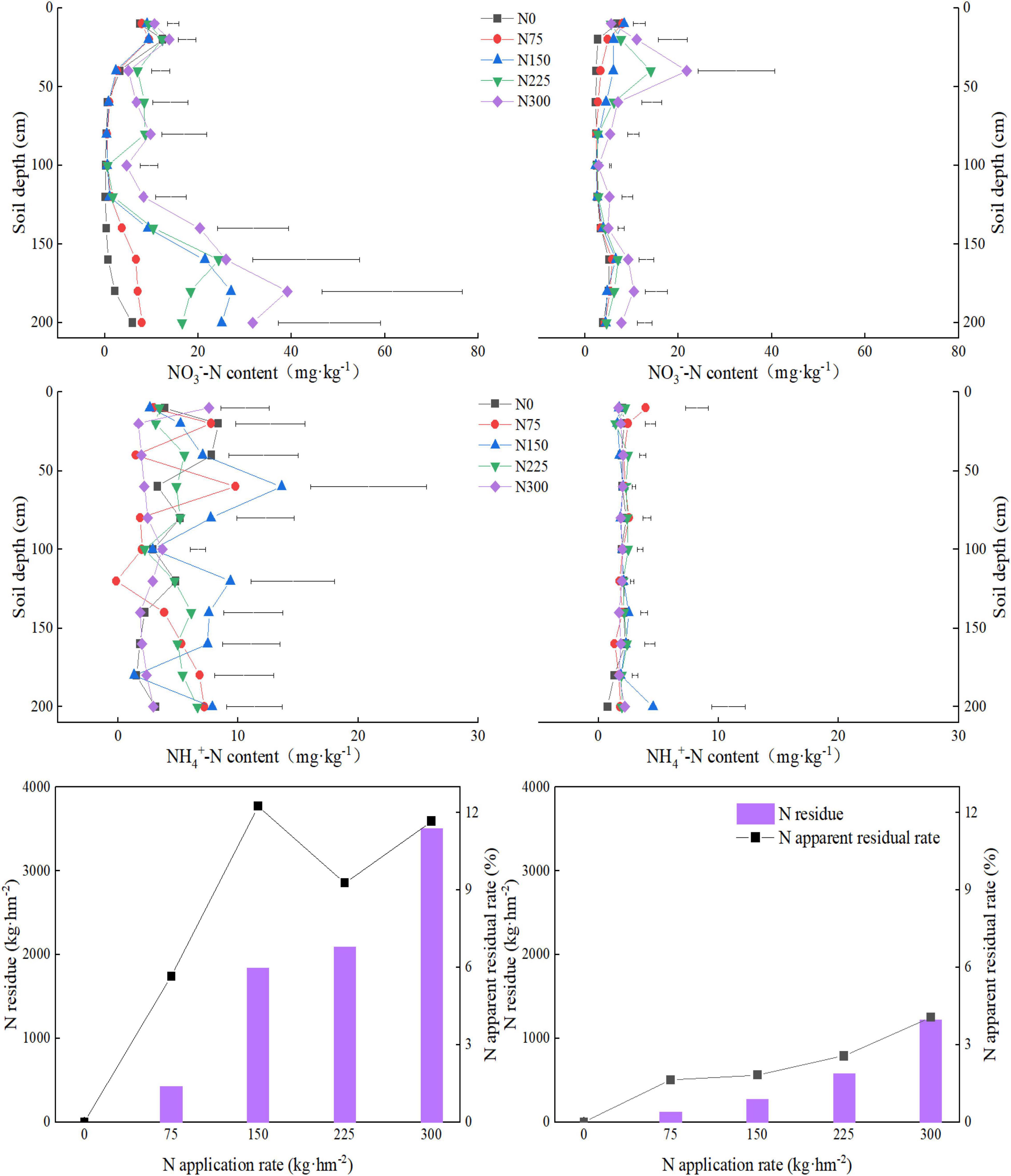
Figure 6. Effect of different nitrogen (N) fertilization rates on NH3–-N, NH4+-N, residual N and N apparent residual rate in winter wheat during 2018 and 2019. The line segment is the LSD-t value obtained by multiple comparisons using the LSD-t method. N0: unfertilized control; N75: N application at 75 kg N⋅ha– 1; N150: N application at 150 kg N⋅ha– 1; N225: N application at 225 kg N⋅ha– 1; N300: traditional N application rate of 300 kg N⋅ha– 1. The left-side figures show data for 2018, and the right-side figures show data for 2019.
Nitrogen treatments significantly affected the yield traits including grains per spikes, 1000-grain weight, and grain yield of winter wheat during both years (Table 6). Among N treatments, maximum 1000-grain weight and seed yield were recorded for N225 which increased 1000-grain weight by 4.46 and 31.02% and grain yield by 29.36 and 66.78% in 2018 and 2019, respectively, compared to the control treatment (N0) (Table 6).
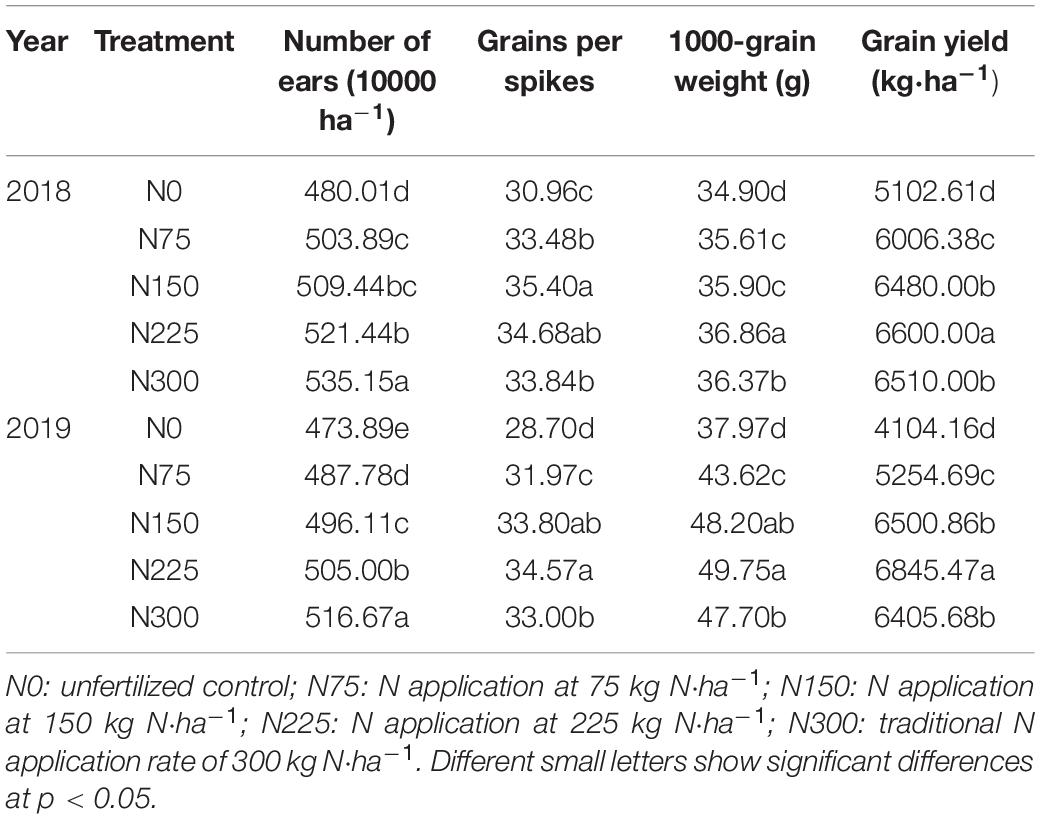
Table 6. Effect of nitrogen (N) application rates on number of ears per hectare, grains per spike, 1000-grain weights, and grain yield of winter wheat during 2018 and 2019.
Leaf area index (LAI) can be used to reflect the growth of plant population and determine the supply status of N. Photosynthetic rates directly reflect the strength of photosynthesis. The SPAD value at flowering stage indicates the relative chlorophyll content of flag leaf In our study, the SPAD value and LAI at flowering stage increased linearly with an increase of N application. Latiri-Souki et al. (1998) also demonstrated that increasing the applied amount of N improved LAI, relative chlorophyll content of flag leaf, and photosynthetic rate for better crop growth and seed yield. Net photosynthetic rate, Ci and Tr are among the important indicators of gasses exchange and photosynthetic activity of plant leaves. In this study, Pn, Ci and Tr of flag leaf were increased with increasing N and maximum values were recorded for N225. On the contrary, Gs was decreased with increasing N rate and minimum values were recorded for N225 in comparison to other treatments. Our results showed that excessive N application at 300 kg⋅ha–1 reduced the photosynthetic performance of winter wheat. However, N application at 225 kg⋅ha–1 was the most beneficial for stomatal gases exchange and photosynthesis. Some published reports also demonstrated that leaves photosynthetic rates increase with increasing N till a threshold level is reached. The number of panicles in wheat increased correspondingly under high N rate, but large population of applied N was not conducive to increase the leaf photosynthesis (Latiri-Souki et al., 1998).
Nitrogen application below the recommended rate retarded the growth and developmental processes in wheat. On the other hand, higher N rates caused significant losses by adding the excess N to soil residual N pools; thereby pollutanting the environment as well (Anas et al., 2020). Nitrogen application rates significantly affected the uptake and transportation of N in winter wheat. In our work, N accumulation in different organs at flowering stage follow the trend as leaf > stem sheath > glume + cob, and N accumulation in grains was significantly increased, ranging from 66.14–173.56 kg⋅ha–1, accounting for 81.60–89.72% of the total N in above-ground plant parts. Also, about 53.26–71.23% of total N was transferred from vegetative organs after flowering stage, indicating that vegetative organs contribute a relatively high proportion to N accumulation in grains. Excessive N application is beneficial for accumulating N in vegetative organs at maturity stage.
The effect of various nitrogen application rates on N efficiency of winter wheat was mainly reflected in absorption efficiency and utilization efficiency. Nitrogen absorption and utilization efficiency were different under different N rates. In this study, with exceeding N rates, nitrogen harvest index, nitrogen partial productivity and agronomic nitrogen efficiency were decreased gradually, and nitrogen absorption efficiency and N contribution rates were consistent where maximum values were recorded for N225. Similar to our findings, Wang et al. (2010) reported that increasing N rates significantly increased the wheat yield, N uptake and utilization efficiency, however, excessive rates caused a significant decline in wheat N utilization efficiency.
In this study, the residual soil N was increased gradually with increase of N rate. In Guanzhong Plain area, remaining soil N after crop harvest tends to move-down after rainfall, resulting in leaching and denitrification losses. Our results showed that the nitrate-N contents are positively related to N application rates. This is consistent with previous studies where increasing N rate caused a significant increase in nitrate-N content (Wang et al., 2010). In this study, the nitrate nitrogen (NO3-N) was mainly concentrated in deeper soil layers (below 120 cm) and varied in different experimental years. As compared with second year of the experiment (2019), nitrate nitrogen contents (NO3-N) in different soil layers were lower in the first year (2018), which may be related to the effect of straw retention. Straw retention combined with N fertilizer is beneficial to improve the plant N utilization efficiency and reduce the leaching N losses. In a previous study, Oikeh et al. (2003) demonstrated that under high N application, soil residual N content kept on increasing with increasing soil depth and were maximum below 1 m soil layer. In our study, ammonium nitrogen content did not vary significantly for tested soil layer.
Fertilizer application combined with straw retention plays an important role in sustainable agricultural production. In this study, compared with N0, grain yield was improved to some extent with exceeding N application rates with increase of 17.71, 26.99, 29.35, and 27.58% in 2018 and 28.03, 58.40, 66.79, and 56.08% in 2019 for N0, N150, N225, and N300, respectively. Straw retention combined with synthetic N fertilizer application effectively increased the wheat yield where maximum yield was recorded during second study year. N150 and N225 treatments recorded higher yield than N300. Previous published reports also showed that N application rates and grain yield showed a quadratic curve where N application increased grain yield within a certain threshold range. When N application rate exceeds the critical range, it results in lower nitrogen use efficiency and environmental pollution (Yang et al., 2017). Reduced number of grains per spike, thousand grain weight, grain yield and water and nutrient use efficiency under excessive N rate were also reported by Liu et al. (2021).
N application rates significantly affected the photosynthesis, plant growth, N use efficiency and productivity of winter wheat under straw incorporation. N application at 150 and 225 kg⋅ha–1 was the most economical method under straw incorporation; it significantly increased the N uptake, N translocation in different plant organs including grains. Compared with N300, N150 and N225 reduced the soil nitrogen losses and in this way contributed to the sustainable agricultural development.
The original contributions presented in the study are included in the article/supplementary material, further inquiries can be directed to the corresponding author/s.
JW: conceptualization, methodology, investigation, formal analysis, writing – original draft, and writing – review and editing. SH: investigation, formal analysis, and writing – review and editing. XS: investigation, formal analysis, and writing – review and editing. TJ: writing – review and editing. ED: writing – review and editing. PZ: writing – review and editing. XC: conceptualization, methodology, and writing – review and editing. XR: conceptualization, methodology, and writing – review and editing. All authors contributed to the article and approved the submitted version.
This study was supported by the Program of Shaanxi Province Key R&D Program (Nos. 2021NY-073 and 2022NY-196), National Natural Science Foundation of China (Nos. 31871580 and 31871562), and Ningxia Hui Autonomous Region Key R&D Program (No. 2019BBF03011). This study was also financially supported by Taif University Researchers Supporting Project number (TURSP-2020/85), Taif University, Taif, Saudi Arabia.
The authors declare that the research was conducted in the absence of any commercial or financial relationships that could be construed as a potential conflict of interest.
All claims expressed in this article are solely those of the authors and do not necessarily represent those of their affiliated organizations, or those of the publisher, the editors and the reviewers. Any product that may be evaluated in this article, or claim that may be made by its manufacturer, is not guaranteed or endorsed by the publisher.
The authors extend their sincere appreciation to Taif University for funding current work by Taif University Researchers Supporting Project number (TURSP-2020/85), Taif University, Taif, Saudi Arabia. The authors grateful to Junfeng Nie, Baoping Yang, Ruixia Ding, and Hui Li for their help with the experiments.
Anas, M., Liao, F., Verma, K. K., Sarwar, M. A., Mahmood, A., Chen, Z. L., et al. (2020). Fate of nitrogen in agriculture and environment: agronomic, eco-physiological and molecular approaches to improve nitrogen use efficiency. Biol. Res. 53, 1–20. doi: 10.1186/s40659-020-00312-4
Bakht, J., Shafi, M., Jan, M. T., and Shah, Z. (2009). Influence of crop residue management, cropping system and N fertilizer on soil N and C dynamics and sustainable wheat (Triticum aestivum L.) production. Soil. Res. 104, 233–240. doi: 10.1016/j.still.2009.02.006
Bhattacharya, A. (2019). Global Climate Change And Its Impact On Agriculture. Changing Climate And Resource Use Efficiency In Plants. Cambridge, MA: Academic Press, 1–50.
Bhattarai, D., Abagandura, G. O., Nleya, T., and Kumar, S. (2021). Responses of soil surface greenhouse gas emissions to nitrogen and sulfur fertilizer rates to Brassica carinata grown as a bio-jet fuel. GCB Bioenergy 13, 627–639.
Dobermann, A. R. (2005). Nitrogen Use Efficiency-State of the Art. Agronomy & Horticulture. Lincoln, NE: Faculty Publications, 336.
Du, Y., Cui, B., Wang, Z., Sun, J., and Niu, W. (2020). Effects of manure fertilizer on crop yield and soil properties in China: a meta-analysis. Catena 193:104617.
Duan, Y., Xu, M., Gao, S., Liu, H., Huang, S., and Wang, B. (2016). Long-term incorporation of manure with chemical fertilizers reduced total nitrogen loss in rain-fed cropping systems. Sci. Rep. 6, 1–10. doi: 10.1038/srep33611
Elser, J. J., Bracken, M., Cleland, E. E., Gruner, D. S., Harpole, W. S., Hillebrand, H., et al. (2007). Global analysis of nitrogen and phosphorus limitation of primary producers in freshwater, marine and terrestrial ecosystems. Ecol. Lett. 10, 1135–1142. doi: 10.1111/j.1461-0248.2007.01113.x
Garg, S., and Bahl, G. (2008). Phosphorus availability to maize as influenced by organic manures and fertilizer P associated phosphatase activity in soils. Bioresour. Technol. 99, 5773–5777. doi: 10.1016/j.biortech.2007.10.063
Ghimire, R., and Machado, S. (2015). Long-term crop residue and nitrogen management effects on soil profile carbon and nitrogen in wheat–fallow systems. Western Soc. Crop Sci. 106, 2230–2240.
Gu, X. B., Cai, H. J., Du, Y. D., and Li, Y. N. (2019). Effects of film mulching and nitrogen fertilization on rhizosphere soil environment, root growth and nutrient uptake of winter 512 oilseed rape in northwest China. Soil Till. Res. 187, 194–203. doi: 10.1016/j.still.2018.12.009
Hafeez, A., Ali, S., Ma, X., Tung, S. A., Shah, A. N., Ahmad, S., et al. (2019). Photosynthetic characteristics of boll subtending leaves are substantially influenced by applied K to N ratio under the new planting model for cotton in the Yangtze River Valley. Field Crops Res. 237, 43–52.
Hartmann, T. E., Yue, S., Schulz, R., He, X., Chen, X., Zhang, F., et al. (2015). Yield and N use efficiency of a maize-wheat cropping system as affected by different fertilizer management strategies in a farmer’s field of the North China Plain. Field Crops Res. 174, 30–39. doi: 10.1016/j.fcr.2015.01.006
Huang, T., Yang, H., Huang, C., and Ju, X. (2017). Effect of fertilizer N rates and straw management on yield-scaled nitrous oxide emissions in a maize-wheat double cropping system. Field Crops Res. 204, 1–11. doi: 10.1016/j.fcr.2017.01.004
Jin, L., Cui, H., Bo, L., Zhang, J., Dong, S., and Peng, L. J. F. C. R. (2012). Effects of integrated agronomic management practices on yield and nitrogen efficiency of summer maize in North China. Field Crops Res. 134, 30–35. doi: 10.1016/j.fcr.2012.04.008
Ju, X., and Gu, B. (2014). Current situation, problems and trends of nitrogen fertilizer application in farmland in China. J. Plant Nutr. Fertil. 20, 783–795. doi: 10.11674/zwyf.2014.0401
Latiri-Souki, K., Nortcliff, S., and Lawlor, D. W. (1998). Nitrogen fertilizer can increase dry matter, grain production and radiation and water use efficiencies for durum wheat under semi-arid conditions. Eur. J. Agron. 9, 21–34. doi: 10.1016/S1161-0301(98)00022-7
Li, Z., Liu, M., Wu, X., Han, F., and Zhang, T. (2010). Effects of long-term chemical fertilization and organic amendments on dynamics of soil organic C and total N in paddy soil derived from barren land in subtropical China. Soil. Till. Res. 106, 268–274.
Liang, K., Zhong, X., Huang, N., Lampayan, R. M., Liu, Y., Pan, J., et al. (2017). Nitrogen losses and greenhouse gas emissions under different N and water management in a subtropical double-season rice cropping system. Sci. Total Environ. 609, 46–57. doi: 10.1016/j.scitotenv.2017.07.118
Liao, Y., Wu, W. L., Meng, F. Q., Smith, P., and Lal, R. J. (2015). Increase in soil organic carbon by agricultural intensification in northern China. Biogeosciences 11, 1403–1413. doi: 10.5194/bg-12-1403-2015
Liu, C., Lu, M., Cui, J., Li, B., and Fang, C. J. (2014). Effects of straw carbon input on carbon dynamics in agricultural soils: a meta-analysis. Glob. Change Biol. 20, 1366–1381. doi: 10.1111/gcb.12517
Liu, S., Lin, F., Wu, S., Ji, C., Sun, Y., Jin, Y., et al. (2017). A meta-analysis of fertilizer-induced soil NO and combined NO+N2O emissions. Glob. Change Biol. 23, 2520–2532. doi: 10.1111/gcb.13485
Liu, Y., Liao, Y., and Liu, W. (2021). High nitrogen application rate and planting density reduce wheat grain yield by reducing filling rate of inferior grain in middle spikelets. Crop J. 9, 412–426. doi: 10.1016/j.cj.2020.06.013
Lou, Y., Xu, M., Wang, W., Sun, X., and Zhao, K. (2011). Return rate of straw residue affects soil organic C sequestration by chemical fertilization. Soil Till Res. 113, 70–73.
MEP (1999). Regulation Of Halting Straw Burning And Implementing Comprehensive Use Of Waste Straw. Avialable online at: http://www.mee.gov.cn/gkml/zj/wj/200910/t20091022_171920.htm (accessed March 22, 2019).
MOA-PRC (2015). Implementation Opinions Of The Ministry Of Agriculture On Conducting Campaign Of Non-Point Pollution Control. Available online at: http://english.agri.gov.cn/governmentaffairs/gaz/201506/t20150608_25790.htm (assessed August 22, 2017).
Morari, F., Vellidis, G., and Gay, P. (2011). Reference Module in Earth Systems and Environmental Sciences. From Encyclopedia of Environmental Health. Amsterdam: Elsevier, 727–737.
Norman, R. J., and Stucki, J. W. (1981). The determination of nitrate and nitrite in soil extracts by ultraviolet spectrophotometry. Soil Sci. Soc. Am. J. 45, 347–353. doi: 10.2136/sssaj1981.03615995004500020024x
Oikeh, S. O., Carsky, R. J., Kling, J. G., Chude, V. O., and Horst, W. J. (2003). Differential N uptake by maize cultivars and soil nitrate dynamics under N fertilization in West Africa. Agric. Ecosyst. Environ. 100, 181–191. doi: 10.1016/S0167-8809(03)00194-4
Scotti, R., Bonanomi, G., Scelza, R., Zoina, A., and Rao, M. A. (2015). Organic amendments as sustainable tool to recovery fertility in intensive agricultural systems. J. Soil Sci. Plant Nutr. 15, 333–352. doi: 10.4067/S0718-95162015005000031
Shah, A. N., Yang, G., Tanveer, M., and Iqbal, J. (2017a). Leaf gas exchange, source–sink relationship, and growth response of cotton to the interactive effects of nitrogen rate and planting density. Acta Physiol. Plant. 39:119.
Shah, A. N., Iqbal, J., Tanveer, M., Yang, G., Hassan, W., Fahad, S., et al. (2017b). Nitrogen fertilization and conservation tillage: a review on growth, yield, and greenhouse gas emissions in cotton. Environ. Sci. Pollut. Res. 24, 2261–2272. doi: 10.1007/s11356-016-7894-4
Shah, A. N., Wu, Y., Iqbal, J., Tanveer, M., Bashir, S., Rahman, S. U., et al. (2021a). Nitrogen and plant density effects on growth, yield performance of two different cotton cultivars from different origin. J. King Saud Univ. Sci. 33:101512.
Shah, A. N., Wu, Y., Tanveer, M., Hafeez, A., Tung, S. A., Ali, S., et al. (2021b). Interactive effect of nitrogen fertilizer and plant density on photosynthetic and agronomical traits of cotton at different growth stages. Saudi J. Biol. Sci. 28, 3578–3584. doi: 10.1016/j.sjbs.2021.03.034
Stevens, W. B., Hoeft, R. G., and Mulvaney, R. L. (2005). Fate of nitrogen-15 in a long-term nitrogen rate study: II. Nitrogen uptake efficiency. Agronom J. 97, 1046–1053. doi: 10.2134/agronj2003.0313
Sun, J., Shen, Z., Cao, J., Zhang, L., Wu, T., Zhang, Q., et al. (2017). Particulate matters emitted from maize straw burning for winter heating in rural areas in Guanzhong Plain. China: current emission and future reduction. Atmos. Res. 184, 66–76.
Tong, X., Xu, M., Wang, X., Bhattacharyya, R., Zhang, W., and Cong, R. (2014). Long-term fertilization effects on organic carbon fractions in a red soil of China. Catena 113, 251–259. doi: 10.1016/j.catena.2013.08.005
Wang, Q., Li, F., Zhao, L., Zhang, E., Shi, S., Zhao, W., et al. (2010). Effects of irrigation and nitrogen application rates on nitrate nitrogen distribution and fertilizer nitrogen loss, wheat yield and nitrogen uptake on a recently reclaimed sandy farmland. Plant Soil 337, 325–339. doi: 10.1007/s11104-010-0530-z
Wei, T., Zhang, P., Wang, K., Ding, R., Yang, B., Nie, J., et al. (2015). Effects of wheat straw incorporation on the availability of soil nutrients and enzyme activities in semiarid areas. PLoS One 10:e0120994. doi: 10.1371/journal.pone.0120994
Weller, S., Kraus, D., Ayag, K., Wassmann, R., Alberto, M., Butterbach-Bahl, K., et al. (2015). Methane and nitrous oxide emissions from rice and maize production in diversified rice cropping systems. Nutr. Cycl. Agroecosys. 101, 37–53. doi: 10.1007/s10705-014-9658-1
Xu, C., Han, X., Ru, S., Cardenas, L., Rees, R. M., Wu, D., et al. (2019). Crop straw incorporation interacts with N fertilizer on N2O emissions in an intensively cropped farmland. Geoderma 341, 129–137. doi: 10.1016/j.geoderma.2019.01.014
Xu, C., Han, X., Zhuge, Y., Xiao, G., Ni, B., Xu, X., et al. (2021). Crop straw incorporation alleviates overall fertilizer-N losses and mitigates N2O emissions per unit applied N from intensively farmed soils: an in situ 15N tracing study. Sci. Total Environ. 764:142884. doi: 10.1016/j.scitotenv.2020.142884
Yang, X., Lu, Y., Ding, Y., Yin, X., and Raza, S. (2017). Optimising nitrogen fertilisation: a key to improving nitrogen-use efficiency and minimising nitrate leaching losses in an intensive wheat/maize rotation (2008–2014). Field Crops Res. 206, 1–10. doi: 10.1016/j.fcr.2017.02.016
Yao, Z., Yan, G., Zheng, X., Rui, W., Liu, C., and Butterbach-Bahl, K. (2017). Straw return reduces yield-scaled N2O plus NO emissions from annual winter wheat-based cropping systems in the North China Plain. Sci. Total Environ. 59, 174–185. doi: 10.1016/j.scitotenv.2017.02.194
Yin, H., Zhao, W., Li, T., Cheng, X., and Liu, Q. (2018). Balancing straw returning and chemical fertilizers in China: role of straw nutrient resources. Renew. Sustain. Energy Rev. 81, 2695–2702. doi: 10.1016/j.rser.2017.06.076
Yousaf, M., Bashir, S., Raza, H., Shah, A. N., Iqbal, J., Arif, M., et al. (2021). Role of nitrogen and magnesium for growth, yield and nutritional quality of radish. Saudi J. Biol. Sci. 28, 3021–3030. doi: 10.1016/j.sjbs.2021.02.043
Yousaf, M., Li, X., Zhang, Z., Ren, T., Cong, R., Ata-Ul-Karim, S. T., et al. (2016a). Nitrogen fertilizer management for enhancing crop productivity and nitrogen use efficiency in a rice-oilseed rape rotation system in China. Front. Plant Sci. 7:1496. doi: 10.3389/fpls.2016.01496
Yousaf, M., Li, X., Ren, T., Cong, R., Ata-Ul-Karim, S. T., Shah, A. N., et al. (2016b). Response of nitrogen, phosphorus and potassium fertilization on productivity and quality of winter rapeseed in central China. Int. J. Agric. Biol. 18, 1137–1142. doi: 10.17957/ijab/15.0217
Yuan, G., Huan, W., Song, H., Lu, D., Chen, X., Wang, H., et al. (2021). Effects of straw incorporation and potassium fertilizer on crop yields, soil organic carbon, and active carbon in the rice–wheat system. Soil Till. Res. 209:104958.
Zhang, A., Cheng, G., Hussain, Q., Zhang, M., Feng, H., Dyck, M., et al. (2017). Contrasting effects of straw and straw–derived biochar application on net global warming potential in the Loess Plateau of China. Field Crops Res. 205, 45–54. doi: 10.1016/j.fcr.2017.02.006
Zhang, C., Ju, X., Powlson, D., Oenema, O., and Smith, P. J. (2019). Nitrogen surplus benchmarks for controlling N pollution in the main cropping systems of China. Environ. Sci. Technol. 53, 6678–6687. doi: 10.1021/acs.est.8b06383
Zhang, P., Chen, X., Wei, T., Yang, Z., Jia, Z., Yang, B., et al. (2016). Effects of straw incorporation on the soil nutrient contents, enzyme activities, and crop yield in a semiarid region of China. Soil Till. Res. 160, 65–72. doi: 10.1016/j.still.2016.02.006
Zhao, H. B., Wang, Z. H., Gao, Y. J., and Zhang, W. F. (2016). Investigation and evaluation of wheat fertilization among farmers in shaanxi province. Plant Nutr. Fertil. Sci. 22, 245–253. doi: 10.11674/zwyf.14243
Zhao, Y. F., and Yin, Y. W. (2015). Problems and countermeasures in the use of fertilizers in China. Chin. Sci.Bull. 60, 3527–3534.
Keywords: nitrogen fertilizer, nitrogen use efficiency, photosynthesis, productivity, straw incorporation, winter wheat
Citation: Wang J, Hussain S, Sun X, Zhang P, Javed T, Dessoky ES, Ren X and Chen X (2022) Effects of Nitrogen Application Rate Under Straw Incorporation on Photosynthesis, Productivity and Nitrogen Use Efficiency in Winter Wheat. Front. Plant Sci. 13:862088. doi: 10.3389/fpls.2022.862088
Received: 25 January 2022; Accepted: 08 February 2022;
Published: 16 March 2022.
Edited by:
Adnan Noor Shah, Khwaja Fareed University of Engineering and Information Technology (KFUEIT), PakistanReviewed by:
Akram Shehata, Alexandria University, EgyptCopyright © 2022 Wang, Hussain, Sun, Zhang, Javed, Dessoky, Ren and Chen. This is an open-access article distributed under the terms of the Creative Commons Attribution License (CC BY). The use, distribution or reproduction in other forums is permitted, provided the original author(s) and the copyright owner(s) are credited and that the original publication in this journal is cited, in accordance with accepted academic practice. No use, distribution or reproduction is permitted which does not comply with these terms.
*Correspondence: Xiaolong Ren, cnhsY3hsQGFsaXl1bi5jb20=; Xiaoli Chen, cnhsY3hsQGFsaXl1bi5jb20=
Disclaimer: All claims expressed in this article are solely those of the authors and do not necessarily represent those of their affiliated organizations, or those of the publisher, the editors and the reviewers. Any product that may be evaluated in this article or claim that may be made by its manufacturer is not guaranteed or endorsed by the publisher.
Research integrity at Frontiers

Learn more about the work of our research integrity team to safeguard the quality of each article we publish.